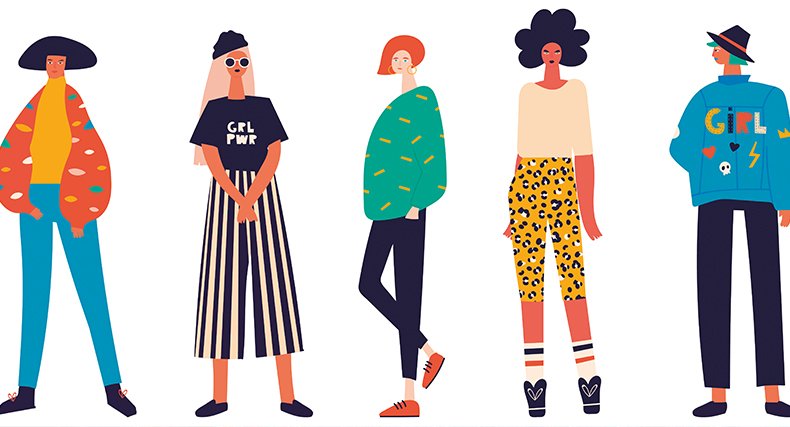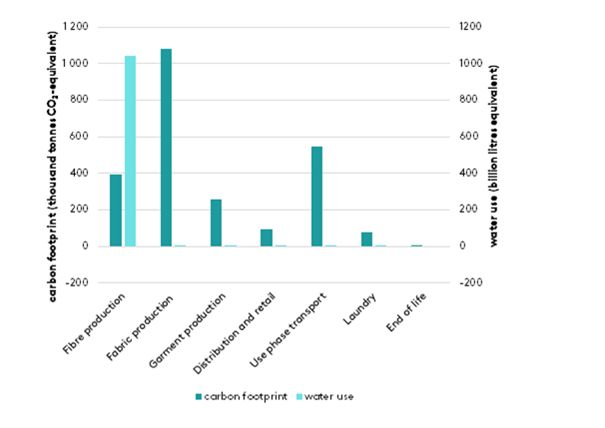
Date: 29 July 2019
With the objective to clarify what sustainable fashion means for the Swedish fashion industry, five key garments were examined using Life Cycle Assessment (LCA), and to give a representative picture of Swedish fashion consumption. LCA is a globally used and accepted method for assessing environmental impacts of a product’s life cycle from cradle to grave, including raw material extraction, material processing, product manufacture, distribution, use, disposal and recycling. The selected garments were: a T-shirt, a pair of jeans, a dress, a jacket and a hospital uniform. The environmental impact of “one average use” of each of these garments was assessed to permit the detailed study, such as the examination of the environmental significance of different life cycle phases. The environmental impact of the five garments was then scaled up to represent Swedish national clothing consumption for one year. This permitted the study of broader aspects, such as the relative importance of different garments and the potential of a range of interventions for impact reduction.
The environmental impact of the garments was expressed using indicators for water use, non-renewable energy use, agricultural land occupation, contributions to climate change (also called “carbon footprint”), freshwater ecotoxicity, freshwater eutrophication, human toxicity (carcinogenic and non-carcinogenic), photochemical oxidant formation, and acidification. The carbon footprint from the Swedish fashion consumption is approximately 0.25 tonnes CO2-equivalents per capita and year. This figure can be compared with the average carbon footprint for a Swedish person, which is around 10 tonnes of CO2-equivalents per year. Although the share from fashion to the total carbon footprint is only 2.5% today, the climate impact from textile consumption needs to be reduced considerably in a sustainable future.

The results of the LCA got scaled up to represent total clothing purchases in Sweden over one year. The water use figures were weighted according to the scarcity of the water in the land it is used. This explains why the fibre production stage dominates the whole life cycle so completely: the use of water for washing clothes in Sweden is less significant since there is an abundance of rain in this country, whereas cotton production frequently challenges the environmental values of the aquatic ecosystems where it occurs. The carbon footprint is more evenly spread among the life cycle phases, but there were two aspects of the result profile that may come as a surprise. One is the significance of the transport of the garment from the retail outlet back to the user’s home (25%), which has generally been ignored in previous studies. This was a surprisingly significant component of the overall life cycle, and tested its significance in sensitivity analyses. The other surprise was the relatively large contribution of the fabric production stage to the carbon footprint. These results suggested that examination of scenarios which reduced the pre-user environmental burden of clothing would be most worthwhile. Several have been examined. In the graph below, the results of two interventions are shown: increasing the life span of garments, and replacing thirsty cotton fibre with forest-based Tencel.

Increasing the practical lifespan of garments is an interesting scenario considering that so much clothing is discarded before the end of its technical lifespan, and so much of the fashion industry’s current output is directed towards “fast fashion” – rapidly produced garments with shorter technical and practical lifespans. The graph shows what happens if the practical lifespan of the average garment is increased by a factor of three, with the simple and unsurprising result (given the previous graph) that the carbon footprint and water use are reduced by 65 and 66 percent respectively. The practical lifespan of some garments might not ever be this much longer, while others may exceed this factor. National statistics on T-shirt consumption, for example, suggest the practical lifespan of these garments can be extended far beyond this. This illustrative scenario is a challenge both to manufacturers, to make and market more durable garments, and consumers, to buy fewer of them.
Replacing cotton with Tencel affects only the T-shirt, jeans and hospital uniform in the other example scenario illustrated in the graph. The key outcome there is the reduction in water use impacts on account of using a biomass resource from non-water stressed regions, so this result supports increased investment in forest cellulosic fibres by the textile industry. The combination of longer lifespan and the use of such forest cellulosic fibre produces the optimum result among the four illustrated here. Achieving such changes in the clothing industry will be a major challenge to existing business models, technical systems and consumer attitudes. This report examines a number of collaborative consumption models that allow the consumers to experience variation in their wardrobes, extending the practical lifespan of garments towards their technical lifespan by shifts in ownership. It also evaluates alternative dyeing techniques and alternative fibres against a wide range of life cycle impact indicators.
The environmental gains from increased lifespan were studied through the collaborative consumption scenarios and the consumer behavior scenarios. The collaborative consumption scenarios showed that there are potential environmental benefits of clothing libraries, second hand stores and rental services, but also a risk of problem shifting: increased consumer transportation can offset the benefits gained from reduced production. This highlights the need for accounting for the logistics when implementing collaborative consumption business models, for example by locating a physical rental service or clothing library in locations close to consumers and/or public transportation, or by implementing internet solutions that require less consumer transportation. The results of the scenarios for changed consumer behavior clearly show that consumer behavior in terms of modes of transportation to and from the store and laundry practices do matter, and that prolonged practical lifespan is a much more effective way for the consumer to reduce the impact of his/her clothing consumption
The potential to do the kind of environmental evaluation presented in this report is continuously improving, with the publication of new data on fibre, fabric and garment production and the improvement in life cycle impact assessment methods. Further work remains to be done on the refinement of data collection methods. For example, the growth of product category rules offers the promise of greater consistency between life cycle assessments, but such rules must properly encompass the garment lifespan if the assessments are to provide useful guidance.
Source: http://mistrafuturefashion.com/output/lca-five-garments/